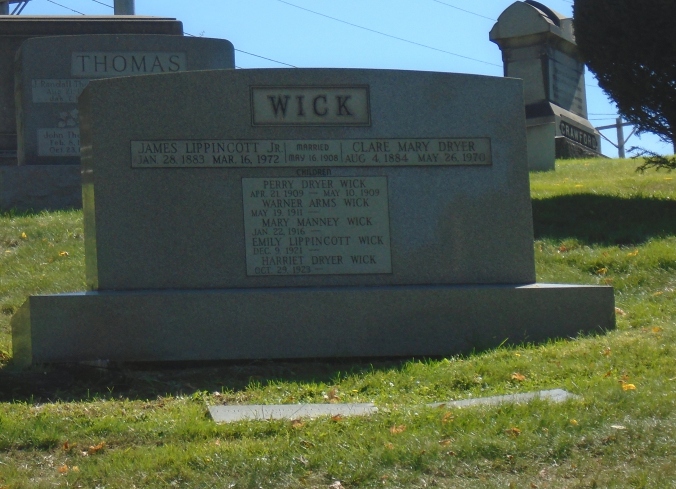
Headstone for James L. Wick, Jr. family plot, Oak Hill Cemetery, Photo by Linda Bunch, all rights reserved, via Find A Grave
Rocky Ridge was a favorite area growing up, whether it was playing on the playground as a child, sledding down the hill below the play area in the winter, playing baseball on one of the diamonds, touch football, or tennis on the tennis courts. As a teen, I was at the skating rink every weekend during the winter and I have memories of going to open air concerts. The one that stands out featured jazz great Lionel Hampton–something I didn’t appreciate at the time!
Formally, the name of this place is the James L. Wick, Jr. Recreation Area. We never called it that, and I have to say I was oblivious to who this gentleman was. In researching him, I found out that I walked by his home on 384 S. Belle Vista (I believe on the corner of S. Belle Vista and Chaney Circle) every day when I went to and from Chaney. The home itself has some history to it, being the original home of Samuel Price, a prominent West Side resident (think Price Road, which is practically across the street from this home). Wick and his wife Clare purchased the home in 1919.
Wick was born into the Wick family, Youngstown royalty of sorts. His father, James Lippincott Wick was a business partner of Freeman Arms (James, Sr. married Julia Arms) and was also associated with G. M. McKelvey’s. James L. Wick, Jr. was born January 28, 1883. He graduated from Massachusetts Institute of Technology, financed by an uncle. He went to work as a general master mechanic at Youngstown Sheet and Tube, then in 1918 took a position as secretary and assistant general manager of Falcon Bronze Company, a bronze foundry. By 1926 he was president, but only separated by a door from the plant where he helped pour a melt and sometimes operated a crane. Wick and Louis M. Nesselbush patented a cooling plate for inwalls and mantles in 1938. He sold the firm to American Brake Shoe Company in 1953.
He played an important role in three Youngstown institutions. He was the chairman of the board of trustees of Youngstown College, later University from 1921 to 1955, overseeing its growth from a night school of the YMCA to a nationally accredited university. Jones Hall, the main building of the university was built under his tenure.
Any of us who write about Youngstown history are indebted to the Mahoning Valley Historical Society. He was one of the incorporators of the Society in 1909 and served two terms as president. His most significant contribution was to help provide a permanent home for the Society and its growing archives. As its president, he persuaded Mrs. Wilford P. Arms to leave her home at 648 Wick Avenue to the society in 1961, and then sold lifetime memberships of $1,000 or more to endow the facility. He remained active with the Society until his death and had a passion for passing along the history of the Valley to its youth, and it was reported he was a lively storyteller.
His other major passion was Mill Creek Park. He knew Volney Rogers, served on the Mill Creek Park board for 21 years until he retired in 1958, could identify trees and shrubs throughout the park, and fought to preserve the park when it was threatened by developers. After his retirement, Rocky Ridge was renamed in his honor, one he could easily visit just a short drive down S. Belle Vista from his home.
He seems kind of a renaissance man. He was a gifted amateur painter, naturalist, inventor, and historian. He was a member of engineering societies, the Youngstown Country Club, a trustee of the Butler, and member of the board of First Presbyterian Church.
I wish I had met him. He passed away on March 16, 1972, my senior year at Chaney. In the words of songwriter Joni Mitchell, “don’t it always seem to go that you don’t know what you’ve got ’til its gone.” I never knew this man, who contributed so much to Youngstown, and did so much that we might know its history, lived along my way to school. I’m glad I know a bit of him now. And perhaps by telling his story, and the story of our city, I can do my small bit to honor his legacy.
Bob
Fine history of Mr. Wick and details about Rocky Ridge. Like you I have many memories about fun activities as a child.
Thanks!
Michelle
LikeLiked by 1 person
Thanks, Michelle!
LikeLike
Well written, We now live in an area in Liberty Twp. that is above the hill and across the street from the Youngstown Country Club. Many of my childhood friends from the north side used to caddy there at YCC. This area that is now mid-class residential was owned by Henry Kirtland Wick and was entitled Alnwick Mansion. This may have been one of the largest estates and private homes from the early 20th century that I know of and had a large write-up in the Vindy back when it was finished. I’ve done a bit of research and it seems that all that’s left is a double line of sycamore trees that may have been planted to line the drive.
LikeLiked by 1 person
Tom, thanks. Sad that some of these treasures have not been preserved. Thanks for sharing your own memories and research!
LikeLike
Pingback: Growing Up in Working Class Youngstown — Emily L. Wick | Bob on Books